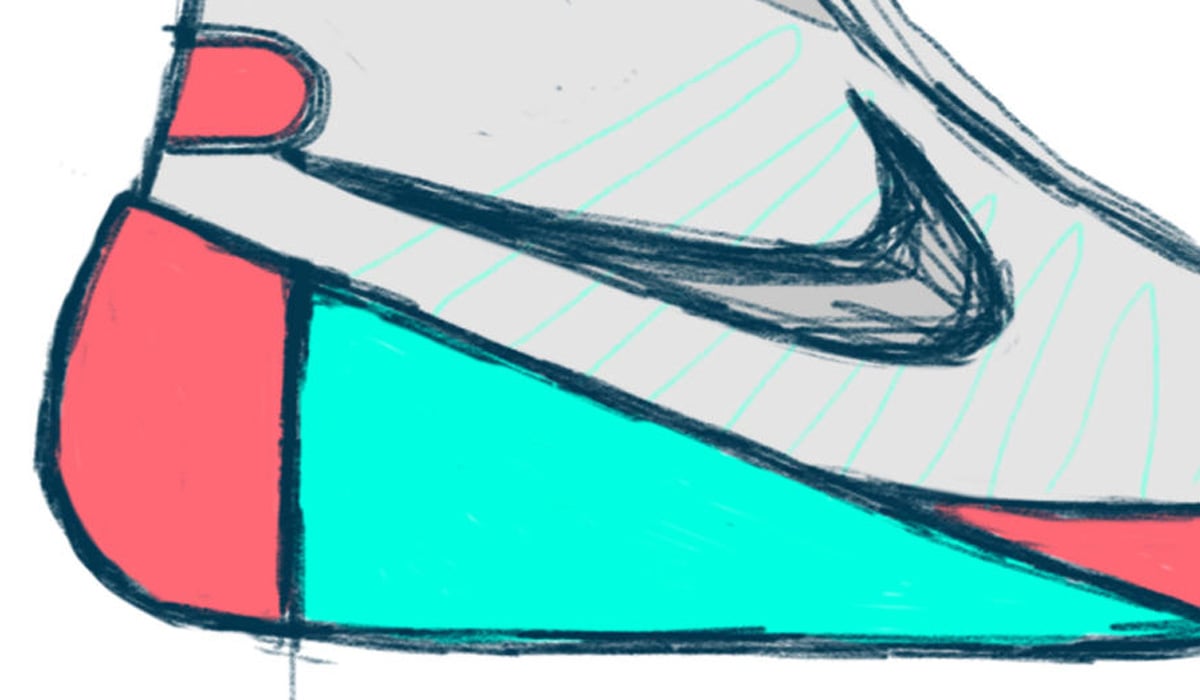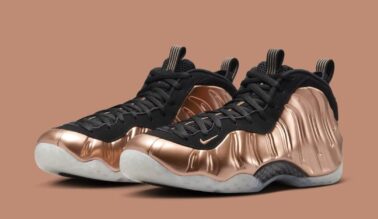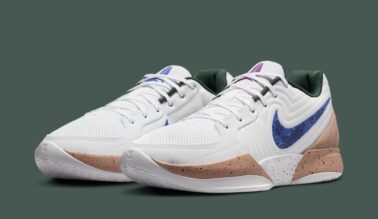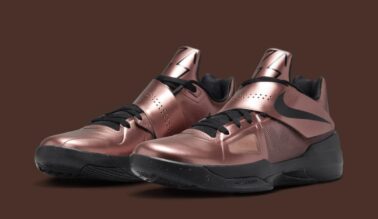This post may contain affiliate links. Please read our disclosure policy.
words & interview // Nick DePaula
When the original Hyperdunk launched in 2008, the shoe marked a new era in many ways. It weighed just 13.0 ounces, which at the time Nike’s CEO Mark Parker said was the lightest basketball shoe to date. (I remember a couple sneakers listed on Eastbay at a shade under 13 ounces before then, but who’s counting, right?) These were real light, even with an all-new high cut silhouette that was new to hoops footwear. They also incorporated Nike’s new Flywire technology, an upper panel simply made of plastic and fabric strands that mostly looked really cool, but also became a marketing dream for the company across all categories. The shoe single-handedly moved the industry towards a focus on lighter weights, with synthetic materials a new focus and leathers a thing of the past.
Nike was so damn confident in the shoe that they even invited media to their sprawling Beaverton, Oregon campus during the summer of 2008 for a detailed walkthrough of the model’s design and development process, along with a “media weartest” of the shoe. Every single brand holds media run events now — but it was unheard of to that point — as sneaker blogs weren’t yet an established presence then and brands were reluctant to host a real-time on-court feedback session. They’d rather just tell you how great the shoes were and have writers relay those claims in their stories.
I’ll never forget the then-head of Nike Basketball turning to us after our interview and saying, “I can talk these up all day long, but what better way to judge them than to lace them up yourselves and give them a run?”
So that’s exactly what we did. With Nike execs and Kobe Bryant himself standing right on the sideline watching us.
As expected, the shoe was an absolute beast, and it featured a combination of what Nike loved to call “lightweight containment” that was entirely new to the game. In the mid-2000s, shoes were beginning to get clunky as hell (see: Shox Bomber), and the Hyperdunk shifted the industry completely away from the two ever-present styles at the time: overly retro-driven models like the Air Force 25 and overly-complex mechanical cushioning setups like the many full-length Shox bricks and adidas’ $250 “computer shoe”, the adidas 1, which quite literally bricked.
“You’ve been with us for the journey, and we always talk about the Hyperdunk in 2008 being a defining moment for us and a new era for innovation in basketball,” Nike Basketball Design Director Leo Chang told me last week. “Before, it was always a leather or a synthetic leather upper on a crazy innovative bottom. The explosion in innovation throughout the whole shoe started with the Hyperdunk in 2008.”
Each year since, the Hyperdunk has become Nike Basketball’s marquee team franchise model, providing players of all sizes with an all-around product that looks to offer up a blend of protection, versatility, traction and cushioning. The newest version, the Hyperdunk 2015, looks to combine the best of each model. There’s the protective higher cut, the midfoot support wedge, tried and true herringbone traction, and most importantly — in my opinion — a return to both heel and forefoot Zoom Air.
To hear all about the latest addition to the editions, I recently caught up with Leo Chang for a full breakdown of the new Hyperdunk 2015.
Nick DePaula: The first Hyperdunk in 2008 was such a landmark shoe. You then did the 2009 on the Hyperize, and then the 2010 and 2011 too. Olivier Henrichot did the 2012 and Peter Fogg did the 2013 and 2014 after that. Once Foggy retired, how’d you decide to take the Hyperdunk series back on?
LC: In my current job, obviously I can’t do everything. [laughs] As the Design Director, I have to overlook all of the line in footwear, and I have a great team of designers that are amazing, so I’m not going to hog all of the projects. Foggy was a great designer and he’d done some pretty legendary stuff, so I trusted him to take it somewhere new. For the ’15 in particular, it was an interesting time, because Foggy had decided to retire from Nike and go ride motorcycles or do whatever the hell he wanted to. [laughs] So, it was a weird transition and we needed someone to design the shoe, so I just hopped back in there.
NDP: With the original Hyperdunk taking some inspiration from the Mag, and this being the 2015 edition, how much did that come into play in terms of offering some inspiration?
LC: That was Avar’s vision from the beginning, and I always thought it was cool to start from there from an aesthetic standpoint. I just love the Mag, and it’s one of my favorite sneakers of all time. It’s just such a cool silhouette, and to this day, it’s still such a futuristic shoe. I wanted to kind of go back to that.
When we did the Hyperize, it was still there, and then 2010 was there through the collar. Then from the ’11, it shifted a bit, but there were components here and there. Through the Foggy era, it diminished a little more, and I felt like being that it was 2015, it’d be a good time to go back to that, but not be too literal.
From an aesthetic standpoint, the idea was around, “What would I do to modernize the 2008 Hyperdunk?” It’s kind of like in iconic cars like Porsches, you see the lineage of the gesture for models like the 911. You see how they evolve, and it’s really iconic and they just modernize it every time. It’s like an iPhone too. Each time, it’s more refined. I wanted to take that approach, and looking at the original Hyperdunk, you had the very iconic triangular shape in the lateral foam stockfit component that was a stability feature on the first one. Then, you had the floating heel clip.
At the time, it was also a very new collar silhouette, and it had the high to low hybrid height. That wasn’t really a thing until the Hyperdunk, and now it’s everywhere. I wanted to look at the silhouette as a point of doing what the Hyperdunk did in having a high collar, but still articulating where it needs to. From there, just cleaning it up and letting the upper be more simple. It felt right to do that. To me, it was a more modernized and sophisticated styling of the original Hyperdunk when you look at it iconically. That all goes back to the Mag too.
NDP: The shoe is really bold in the way it can be blocked, and the NIKEiD options on it are really cool in how versatile it can be blocked.
LC: Yeah, and I had a lot of fun on there! I went a little crazy and got like three colorways on iD. I thought they did a good job of letting you call out those blocks really boldly.
NDP: It’s real good. Did you have specific ways to block it in mind when you were designing it, or were there some alternate blocks along the way that you were toying with?
LC: I wanted to create options, since the Hyperdunk is such a universal shoe. I think it needed to adapt. Sometimes, I love to see the whole triangle wedge plus the heel part blocked as one. And other times I think it’s cool when just the triangle alone is. Or you could also do the heel and triangle in colors separately. You could have those options and that can help to extend the life of it. It was always about keeping the toolbox open.
NDP: It seems like a “Best Practices” Hyperdunk to me, combining the best of all of the models through the years. You’ve got the protective top line, the clean upper, herringbone traction and you brought Zoom Air back into the fold. I’m definitely most excited about that. The last Hyperdunk to have Zoom was also the last one you designed. Why’d you decide to bring it back after the shoe featured Lunar for three years in a row?
LC: From a performance standpoint, it was kind of a reset. I wasn’t in love with Lunar. Most people were neither here nor there with it, in terms of players. They couldn’t really feel the difference of it, and over time, it just didn’t evolve enough for me. I just felt like it got more vanilla over time, and I want there to be a feel of something. The responsiveness of Zoom is something that basketball players love all around. To bring that back into the shoe was, I think, a no brainer. That doesn’t mean we’re off of Lunar altogether, but I think when we get the right formulation of that, we’ll use it again. It just felt like the right time to get away from it.
NDP: Other than being used in the insole of the Kobes, is it not in the line otherwise as an embedded unit for this upcoming season?
LC: It works great as a drop-in configuration on the Kobes, and it’ll be around. For me, Zoom is a great basketball technology though.
NDP: For the separate heel and forefoot Zoom units here, are they a 14 and 8 mm size, or what are they?
LC: Yeah, it’s exactly that.
NDP: With the shoe being such a universal shoe for players of all sizes, what kind of feedback have you been getting from all of the guys that’ve been playing in it?
LC: There’s a few things on the tooling that we did after hearing feedback from the past. One, is we switched to Zoom, as I mentioned, which is a step towards where we were in the ’11 and is great to get that responsiveness back. Another thing is we used a Phylite midsole, similar to the HyperRev, and on the lateral side it wraps over the outsole.
The reason why we did that is because the Hyperdunk is such a big team shoe, and durability was something that was important. We wanted to make sure it was fairly bullet proof. Typically, what we see from our college players and elite players who are doing two-a-days and just going so hard, is that on the lateral side, the outsole rubber wrap can peel out. When you look at all of the defectives that we get back, the common area for issues is on the rubber wraps through the forefoot on the lateral side. Most consumers who aren’t at that elite college level don’t ever experience that.
NDP: Yeah, I’ve never quite had a peel out [laughs], but I’ve got a friend with a 40” inch vert that’s crazy explosive and it’s happened to him a few times.
LC: Some guys will just shred their shoes, so that was an area to look at. We wanted to bring in a foam that was ground-contactable, like a Phylite material, and wrap the outsole on the lateral side to protect it, so that you’d eliminate some of the delamming that would happen with rubber. It makes it more durable, and more flexible.
NDP: When the first Hyperdunk was launched, it was always bounced around between Vectran, Kevlar and ultimately Nylon for the Flywire strand material. What are you guys using here?
LC: The original one used a poly-based core, and we ended up using the Kevlar in the 2011 Elite, which reduced the stretch even more, which was great.
NDP: Man, that’s the best playing shoe of the last five years for me.
LC: Yeah, that was a great shoe. The 2015 edition now has a little bit of a wider cable in it, it’s about a 2 mm width, and we’re using less cables, but each one is a little wider and tougher. We sandwiched it between bonded mesh layers so that you get that feel of it conforming better, and it’s less boardy than synthetics. We just wanted the shoe to have that natural feel and also be contained around that.
image above courtesy Jeremy Rincon




